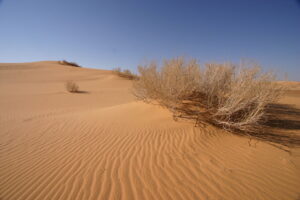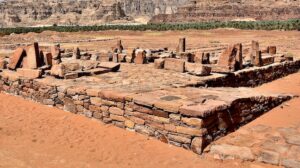
To traverse across this land for more than 30 minutes, anyone would need a good hat, sturdy shoes, eye shades, a good dose of sun block lotion, and an ample portable supply of fresh water. Those are just the basics. Anything more depends on your planned time, distance and activity.
This is, as was once also popularly described about the lunar surface, a magnificent desolation. The Great Nefud Desert spreads as an expansive oval shaped region across northern Saudi Arabia for about 70,000 square kilometers, characterized by rocky elevations of rock and sand ranging from 600 to 1,000 meters. Its face moves with shifting red sands, lifted by perpetual strong winds. Isolated red sandstone massifs pockmark the terrain, sculpted by tens of thousands of years of wind action, creating in some places an almost surreal landscape with an otherworldly feel. Summer temperatures can typically range between 30 to 54 degrees Celsius (between 85 and 120 degrees Fahrenheit). It goes without saying that vegetation is sparse, though a significant presence of ephemeral plants can be seen during ‘wet’ years. Despite the desolation here, modest communities of hyenas, jackals, wildcats, ungulates like gazelle, rodents and lizards make it their domicile.
___________________________________
___________________________________
Today, humans live here, too. Concentrated primarily in lowland areas such as near the Hejaz Mountains, they manage and inhabit oases where dates, vegetables, barley, and fruits are grown. Indeed, an entire city of about 20,000 people —Jubbah — is completely surrounded by the Nefud. Thus in modern times, people have learned how to live and even thrive in this desert.
___________________________________
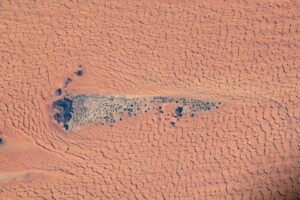
Jubba as viewed from space. Public Domain, Wikimeda Commons
___________________________________
Following The Water
The Nefud was not always like this. In recent years, teams of scientists have walked and camped across the region, surveying, sampling, excavating, studying and documenting sites that today present evidence of ancient lakes — in geologic parlance, lacustrine deposits — of which many date back at least several hundred thousand years. One can see the remnants of these ancient lakes by walking across the surface, and especially by viewing the surface from aerial vantage points. They have a different color and consistency from what is often a context of windblown, sandy dunes. In these places, scientists have uncovered fossils and other evidence of water-endowed spaces that, tens of thousands of years ago, were frequented or inhabited by a variety of animal and plant species — ecosystems much like the savannas of Africa we see today. By analyzing the recovered fossils, climate models and records, and the lacustrine sediment records of these ancient lake remnants, scientists have discovered that, at wetter intervals in this desert environment’s arid past, ‘greener’ conditions afforded a critical accommodation for fluctuating communities of life.
The site of Ti’s al Ghadah in southwestern Nefud presents a perfect example of this. This site is located within an internal depression, or basin. As a 630-meter area ancient paleo-lake deposit outcrop, it has been dated to Pleistocene times and contains a rich array of fossil fauna.
“Ti’s al Ghadah is one of the most important palaeontological sites in the Arabian Peninsula and it currently represents the only dated collection of middle Pleistocene fossil animals in this part of the world, and includes animals such as elephant, jaguar and water birds,” says Mathew Stewart of the University of South Wales, lead author of a 2019 published study/paper* on the results of taphonomic and zooarchaeological investigations at the site.** Most notably, the paper documented the discovery of stone tools spatially associated with evidence of butchery of animals dated to between 500,000 and 300,000 years ago.
The implications were enormous. There were humans here — or, more accurately, hominins —even before the emergence of our own species, Homo sapiens. Said Michael Petraglia, the Ti’s al Ghadah project principal archaeologist and paper co-author, “This makes Ti’s al Ghadah the first, early hominin-associated fossil assemblage from the Arabian Peninsula, demonstrating that our ancestors were exploiting a variety of animals as they wandered into the green interior.”
__________________________________

A trench at the site of Ti’s al Ghaddah, where a large collection of animal fossils dating to approximately 500,000 years ago have been found. Photo: Palaeodeserts Project, from One Small Arabian Fingerbone, by Huw S. Groucutt, Popular Archaeology July 7, 2018.
__________________________________
Who were these hominins? If not Homo sapiens, then what species? Scientists don’t know the answer to this question, but researchers have discovered other sites that have demonstrated a hominin presence in Arabia. An Nasim, a paleo-lake site in an internal basin like Ti’s al Ghadah within the Nefud, was found to contain Acheulean-type stone tools, along with other fossil fauna, dated to between 350 and 250 ka (thousand years) ago. And the list of new artifact discoveries at similar sites continues to expand, including a remarkable recent discovery at another paleo-lake site in the Nefud known as Al Wusta in 2016………
Bone
The evidence for hominin occupation around the ancient paleo-lakes of Arabia has been evidenced primarily through stone tool artifact finds, including some proof of usage for processing animals at sites like Ti’s al Ghadah and the discovery of hominin footprints at the Alathar ancient paleolake deposit located within the western Nefud****. But Huw Groucutt, an archaeologist at the University of Oxford who has played a key role in the ongoing research on early humans in the Arabian Peninsula, tells the story of a tantalizing discovery made while investigating sites in the Nefud region:
“We made a quick visit to Al Wusta in 2014, which involved driving down steep dunes to the base of an inter-dunal depression. We noted some stone tools and interesting sediments, but it was late in the day and the sun was getting low in the sky so we did not stay long. It was clearly an interesting site, but we located dozens of interesting sites. It was a place to which we wanted to return at some point, and our team member Prof Nick Drake (Kings College London) kept mentioning the site as something that looked significant. In 2016 we returned to the site with a large interdisciplinary team of international and Saudi scholars. We walked to the far end of the site where we had not previously been, and immediately found numerous animal bones and human-made stone tools on the surface. These were scattered around deposits of lake sediments. Then our colleague, Dr Iyad Zalmout from the Saudi Geological Survey, picked up a small and well preserved fossil.”
The find turned out to be a human intermediate phalanx (middle finger bone, the bone from the knuckle toward the end of the finger). By employing a series of chronometric dating techniques, scientists were able to determine the age to be between 95-86 thousand years old.
That made this find rare and remarkable, as it represented the only direct fossil evidence ever found of human habitation in the region as long ago as nearly 90,000 years BP.
__________________________________
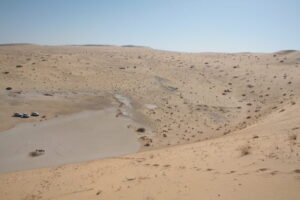
The Al Wusta site from the top of a neighboring sand dune. Photo: Ian Candy. From One Small Arabian Fingerbone, by Huw S. Groucutt, Popular Archaeology July 7, 2018.
__________________________________
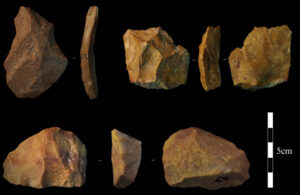
Lithic artifacts (stone tools) from Al Wusta. Top row: two Levallois flakes, bottom: Levallois core. Photo: Eleanor Scerri. From One Small Arabian Fingerbone, by Huw S. Groucutt, Popular Archaeology July 7, 2018.
__________________________________
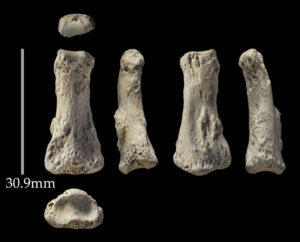
The Al-Wusta 1 intermediate phalanx fingerbone. Photo: Ian R. Cartwright. From One Small Arabian Fingerbone, by Huw S. Groucutt, Popular Archaeology July 7, 2018.
__________________________________
What kind of human?
So the phalanx was human, but to what species of human did it belong? Given the age, could it be Neanderthal?
“In many cases, a single fossil would not be enough to determine the species represented,” says Groucutt. “In the case of the finger bone, however, we are lucky in that this bone is very different in Neanderthals and Homo sapiens. In basic terms, Neanderthal intermediate phalanges are relatively shorter and are generally more robust, while those of Homo sapiens are relatively longer and are more gracile. The [measurement] values for the Al Wusta finger bone clearly aligns it with Homo sapiens.”
Combined with the associated lithics, the case then became a slam-dunk for early modern humans. Many of the Al Wusta site artifacts “feature an emphasis on centripetal Levallois technology”, says Groucutt. This is a manufacturing technique typical of Middle Paleolithic/Middle Stone Age period stone tools, common among finds associated with the early modern human presence at other sites, such as in east and north Africa.
______________________________________
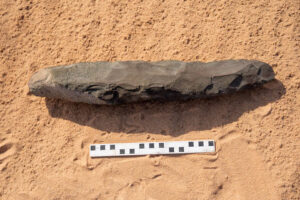
Above and below: Stone “hand axe” artifacts very recently discovered by an international team of archaeologists working with The Royal Commission for AlUla (RCU), directed by Dr Ömer ‘Can’ Aksoy and Dr Gizem Kahraman Aksoy of TEOS Heritage. These artifacts have been assessed on a preliminary basis as over 200,000 years old, assigning them to the Lower-Middle Palaeolithic period. Courtesy Royal Commission for AlUla (RCU) as reported in RCU news release, Giant Stone Hand Axe May Rewrite Prehistory in Saudi Arabia.
__________________________________
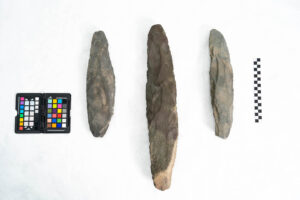
__________________________________
Dispersal into Green Arabia
Luminescence dating of the sediments at the paleo-lake deposit sites indicates that the dates for the evidence of hominin occupation occurred at a time of higher rainfall in the region, when freshwater lakes, wetlands and rivers formed, inviting development of migration routes for animal species……. and hominins.
“It’s remarkable; every time it was wet, people were there,” says Petraglia from the Max Planck Institute for the Science of Human History. “This work puts Arabia on the global map for human prehistory.” As more evidence of hominin occupation in the region mounts, scientists are becoming increasingly convinced that the Arabian Peninsula was an important corridor for dispersal of hominins out of Africa into the rest of the world, occurring in different waves and at different times in prehistory.
And the findings portend the development of a broader and more complex story on human evolution. “Arabia has long been seen as empty throughout the past,” says Groucutt. “Our work shows that we still know so little about human evolution in vast areas of the world and highlights the fact that many surprises are still out there.”
______________________________
There is much more. Read the complete article.
______________________________
Advertisement

EXPLORE THE ANCIENT ETRUSCANS IN PERSON!
Experience a unique, up-close-and-personal hike among ancient hilltop towns in central Italy. You will walk the sensational countryside of the regions of Umbria and Tuscany, soaking in important sites attesting to the advanced Etruscan civilization, forerunners of the ancient Romans; imposing architectural and cultural remains of Medieval Italy; local food and drink; and perhaps best of all — spectacular scenic views! Join us in this collaborative event for the trip of a lifetime!

